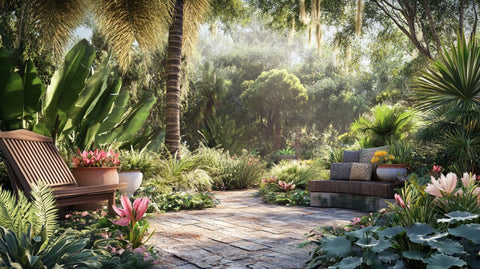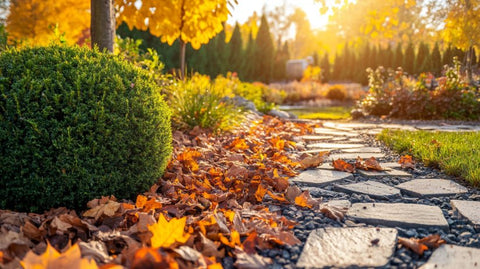Introduction:
Florida, often synonymous with sunny skies and diverse wildlife, is also home to an extraordinary range of wild plants. This is due, in large part, to its unique climate and ecosystems that merge subtropical warmth with coastal breezes. These pristine environments provide the perfect nursery for a myriad of plant species, each playing a pivotal role in the ecological web.
Wild plants are not only vital for maintaining ecological balance; they are also a treasure trove for plant enthusiasts and ecologists alike. Let's dive into the enchanting world of Florida's wild flora and uncover some intriguing stories and facts that you might not know.
Did you know that the oldest living tree east of the Mississippi River, an ancient cypress known as "The Senator," was found in Florida? It was believed to be over 3,500 years old, standing as a timeless testament to the resilience and longevity of Florida's native plants.
The Diverse Ecosystems of Florida
Florida's rich biodiversity can be attributed to its varied ecosystems, each hosting unique plant life that thrives under specific conditions. Let's explore some of these ecosystems and the fantastic flora they sustain.

Coastal Mangroves and Salt Marshes
The coastal mangroves and salt marshes are essential buffers against coastal erosion and serve as breeding grounds for numerous marine species. These habitats are teeming with life and feature some remarkable plant species.
Red Mangrove (Rhizophora mangle)
Known for its striking stilt roots that lift the plant above the water's surface, the Red Mangrove is crucial for protecting coastlines against erosion. These plants create a perfect nursery for young marine animals and help in maintaining water quality.
Salt Marsh Cordgrass (Spartina alterniflora)
This hardy grass dominates Florida's salt marshes and is vital in trapping sediments, which helps in building landforms over time. Its dense growth provides shelter and breeding grounds for a variety of wildlife.

Forests of the Pine Flatwoods
Pine Flatwoods, characterized by their open canopy of pine trees and a rich understory of shrubs and herbs, are one of the most widespread ecosystems in Florida.
Slash Pine (Pinus elliottii)
The towering Slash Pine is the cornerstone of the Pine Flatwoods. These trees are well-adapted to the frequent fires that rejuvenate the ecosystem, with thick bark that protects their inner layers from heat.
Palmetto (Sabal palmetto)
Commonly known as the Cabbage Palm, the Palmetto is not only an iconic symbol of Florida but also a resilient plant that thrives in sandy soils. Its dense fiber was traditionally used by Native Americans for weaving baskets and mats.

Everglades – A Unique Subtropical Wilderness
The Everglades is a vast, slow-moving river of grass that hosts a complex array of plant species which have adapted to the waterlogged conditions.
Sawgrass (Cladium jamaicense)
Despite its name, Sawgrass is not a true grass. Its sharp, serrated edges deter herbivores and help this plant dominate the ecosystem. It's a fundamental component of the Everglades’ landscape, supporting various wildlife species.
Cypress Trees
Towering like sentinels in the swamps, Cypress trees, particularly the Bald Cypress, are known for their distinctive "knees," which protrude from the water. These knees are thought to aid in oxygen exchange and support the tree in its saturated environment.

Choosing Florida’s Native Plants for Your Garden
Incorporating native plants from the wild landscapes of Florida into your garden can bring resilience, beauty, and environmental harmony. Native plants are adapted to the local climate, making them low-maintenance and beneficial for native wildlife.
Benefits of Native Gardening
- Conservational Impact: Native plants support local pollinators and wildlife, promoting biodiversity.
- Water Efficiency: These plants often require less watering as they are accustomed to Florida’s rainfall patterns.
- Pest Resistance: Naturally adapted to local pests, native plants reduce the need for chemical pesticides.
Top Native Plants to Consider

Coontie (Zamia integrifolia)
A low, clump-forming plant that resembles a small palm, Coontie is a hardy, drought-tolerant choice for gardens. Its glossy leaves and unusual reproductive structures add visual interest year-round.
Beautyberry (Callicarpa americana)
Known for its clusters of vibrant purple berries, the Beautyberry provides food for birds and is a lovely addition to any garden, offering beauty throughout the seasons.
Integrating Tropical Allure with Plantology
For those looking to recreate a bit of Florida's wild magic in their personal spaces, Plantology offers a selection of exotic plants that can thrive in your garden, bringing a touch of the Sunshine State to your home.
Consider the Adonidia Palm in its various forms—Single, Double, or Triple—which provides that lush, tropical look Florida is famed for.
Visit our website to explore a wide array of options perfect for your gardening ambitions.

Wild Medicinal Plants of Florida
Florida is not just a haven for horticulturists but also for those who seek herbal medicine. The state's wild landscapes are dotted with plants known for their healing properties, many of which have been used by indigenous people for centuries.
Yaupon Holly (Ilex vomitoria)
Once consumed as a caffeinated beverage by Native Americans, Yaupon's leaves can be brewed into tea. These leaves are rich in antioxidants and caffeine, making them a local alternative to traditional tea and coffee.
Lemon Balm (Melissa officinalis)
This soothing herb grows wild in shaded areas of Florida and is celebrated for its calming effects. Its leaves can be used to make a relaxing tea, and the plant itself is a lovely addition to herb gardens.

Plantology’s Offerings for Your Herb Garden
Expand your collection of beneficial plants with some of our finest selections that bring both beauty and functionality. Consider the Agapanthus, Lily of the Nile, known for its stunning blooms and potential health benefits.
Visit Plantology’s website to find more plants that can transform your garden into a sanctuary of well-being.
The Conservation of Florida’s Wild Flora
While the natural beauty of Florida's flora is undeniable, it faces significant threats from various fronts. From urban development to climate change, the preservation of these wild plants is crucial for maintaining the health and balance of ecosystems.
Threats to Native Plant Species
- Habitat Loss: Urban expansion and agricultural intensification have led to the fragmentation of natural habitats.
- Invasive Species: Non-native plants can outcompete local flora, disrupting ecological harmony.
- Climate Change: Shifting weather patterns threaten the delicate balance needed for many plant species to survive.
Efforts and Initiatives for Conservation
Numerous organizations and local governments are actively working to protect Florida's native plants through conservation areas, education, and restoration projects. Home gardeners can contribute by choosing native plants for landscaping and supporting conservation initiatives.
Conclusion: Embracing the Wild and Wonderful World of Florida Plants
Florida's vastly diverse plant life is more than just a passively beautiful backdrop — it's an active, integral part of the state's rich ecosystem. Embracing native plants in our gardens not only supports the local environment but also enriches our spaces with resilience and natural charm.
Whether you're captivated by the mystical mangroves, intrigued by the sandy flatwoods, or charmed by the Everglades' array of aquatic plants, Florida offers an expansive botanical banquet that continues to inspire and surprise.
Explore the beauty and utility of Florida's wild plants at Plantology and discover how you can incorporate these wonders into your personal green spaces. Happy planting!
Exploring the Intricate Plant Communities of Florida's Unique Habitats

Florida’s unique geographical positioning and climatic conditions have given rise to a dazzling assembly of plant communities that are unparalleled in diversity and complexity. From the Kissimmee Prairie to the subtropical hammocks, each habitat sustains an intricate web of plant life that not only enthralls botanists but also serves as a sanctuary for countless wildlife species. Let us explore these remarkable plant communities and understand their roles within Florida's ecological mosaic.
Pine Rocklands: A Unique and Disappearing Habitat
Located predominantly in South Florida, particularly within the Miami Rock Ridge, Pine Rocklands are characterized by a canopy of South Florida Slash Pines and a rich herbaceous layer teeming with endemic plant species, many of which can only be found in this ecosystem.
South Florida Slash Pine (Pinus elliottii var. densa)
The South Florida Slash Pine is an integral part of the Pine Rocklands, adapted to withstand the periodic fires that are essential to maintaining this ecosystem. Its thick bark acts as a protective shield against fire, while its seeds benefit from the nutrient-rich ash bed left behind by burning.

Florida Silver Palm (Coccothrinax argentata)
Endemic to the Pine Rocklands, the Florida Silver Palm is notable for its striking silver-hued fronds that shimmer in the sunlight. This palm is not only an aesthetic marvel but also supports habitat integrity by stabilizing the soil and offering refuge to various pollinators.
Tropical Hardwood Hammocks: Biodiversity Hotspots
Found throughout the state, tropical hardwood hammocks are dense stands of broadleaf trees forming closed canopies that create a cool microenvironment beneath. These hammocks serve as refuges for many rare and endangered plant species, as well as migratory birds seeking respite.
Gumbo Limbo (Bursera simaruba)
Often called the "tourist tree" due to its red, peeling bark, Gumbo Limbo is a resilient species thriving in the hammocks. Known for its ability to regenerate from fallen branches, it stands as a symbol of adaptability in Florida's dynamic environments.

Jamaica Dogwood (Piscidia piscipula)
With its fragrant leaves and bark, Jamaica Dogwood is valued not only for its ecological contribution but also for its traditional medicinal use. This tree is often found in hammocks, providing dense shade and supporting a myriad of understory species.
Freshwater Marshes and Wet Prairies
The freshwater marshes and wet prairies of Florida are vast watery expanses that stand as vital components in the state's water cycle. These habitats are rich with plant species specially adapted to life in waterlogged conditions and are often swarmed with life.
Maidencane (Panicum hemitomon)
A dominant grass in freshwater marshes, Maidencane forms dense stands that create crucial habitat for fish and aquatic invertebrates. Its nutritional value and shelter make it indispensable in the marsh ecosystem, serving as a primary food source for wildlife.

Alligator Flag (Thalia geniculata)
With its striking purple flowers and lush green leaves, Alligator Flag makes a statement in the landscape. This plant is not just visually appealing but also essential for pollution filtration and providing habitat for insects and amphibians.
The Importance of Preserving Native Plant Communities
The myriad plants within Florida's ecosystems are woven into a rich tapestry that underpins the state's natural heritage. Understanding and preserving these plant communities is crucial for sustaining Florida's environmental health, providing resilience against climate fluctuations, and ensuring that the state's wild beauty endures for future generations.
Restoration Efforts: Breathing Life Back into Depleted Areas
Various conservation organizations across Florida are actively engaged in restoration projects aiming to revive foregone native habitats. Through alliances with local governments, these organizations have successfully initiated controlled burns, invasive species removal, and native plant reintegration to foster healthy ecosystems.

Community-led efforts play a significant role in these initiatives, encouraging citizen participation in habitat restoration to instill a shared sense of environmental stewardship. Such involvement not only restores balance to disrupted ecosystems but also reconnects people with the land’s natural history.
Gardening with Florida's Native Plants: A Sustainable Choice
Embracing Florida's native plants in home and community gardens can dramatically contribute to the state's ecological conservation goals while providing gardeners with stunning and resilient landscapes. The benefits of native gardening go beyond aesthetics, actively participating in sustaining local biodiversity.
Creating a Native Plant Wildlife Oasis
- Supporting Pollinators: Select plants known to attract native bees, butterflies, and hummingbirds. Species like Wild Senna and Bee Balm can serve as pollinator magnets.
- Sustaining Birds: Incorporate plants that offer seeds and berries, such as Elderberry and Winged Sumac, to provide food and habitat for avian visitors.
- Drought Tolerance: Use native plants that have evolved to endure fluctuations in water availability, reducing the need for supplemental irrigation.
Exploring Florida Native Plant Nurseries
For sourcing native plants and gaining expert advice, Florida's native plant nurseries provide gardeners with a comprehensive resource. They offer diverse selections of local flora along with guidance on cultivating sustainable gardens that reflect and preserve Florida's natural ecosystems.
Connect with organizations like the Florida Native Plant Society to gain access to workshops, plant sales, and resources that will enhance your garden's ecological health.
Florida Wildflower Extravaganza: Season-by-Season Bloom Guide
The state of Florida is blessed with a kaleidoscope of wildflowers that paint the landscape with vibrant colors throughout the year. Knowing when and where to find these botanical spectacles can enrich the understanding and appreciation of Florida's wild beauty.
Spring Awakening
- Coreopsis (Coreopsis leavenworthii): As Florida's state wildflower, Coreopsis heralds the arrival of spring with its radiant golden blooms.
- Spiderwort (Tradescantia ohiensis): Embellished in shades of blue and purple, Spiderwort adds a touch of whimsy to spring landscapes.
Summer Splendor
- Partridge Pea (Chamaecrista fasciculata): With its cheerful yellow blooms, Partridge Pea brightens the summer months while benefiting native pollinators.
- Blazing Star (Liatris sp.): Known for its tall spikes brimming with purple flowers, Blazing Star exudes elegance and sustenance for butterflies.
Autumn Harvest
- Marsh Pink (Sabatia stellaris): Adorning fall landscapes with delicate pink flowers, Marsh Pink thrives in coastal areas.
- Goldenrod (Solidago sp.): Often misunderstood, Goldenrod’s lovely yellow blooms play a critical role in seasonal pollen provisions.
Winter Wonders
- Sandhill Milkweed (Asclepias humistrata): Even in winter, its unique orb-shaped clusters attract attention amidst dormant surroundings.
- American Beautyberry (Callicarpa americana): While berries provide food throughout, winter ushers in especially vibrant shades to uplift spirits.
Education and Advocacy: Fostering a Culture of Environmental Awareness
Awareness and education are key components in fostering a culture of conservation that values Florida's unique plant heritage. Educational programs, workshops, and guided tours in state parks and nature reserves offer practical insights into native plant ecosystems, inspiring current and future generations to become dedicated stewards of the land.
Partnerships with schools and community groups extend educational outreach, creating platforms for environmental advocacy and fostering young talents in ecology. Encouraging children and adults alike to share what they learn can cultivate a community-wide commitment to sustainability and conservation.

Conclusion: Florida’s Natural Tapestry and Our Role in Its Preservation
Immersing oneself in the enchanting world of Florida’s flora reveals the unparalleled beauty and ecological importance of plant communities that grace the Sunshine State. By advocating for and honoring these natural treasures, we can ensure a flourishing legacy for generations to come.
Whether as dedicated native plant gardeners, conservation volunteers, or avid nature enthusiasts, our collective efforts contribute to the preservation of Florida’s lush biodiversity. Embrace the wild wonder, cultivate respect for the intricate ecosystems, and nurture the landscapes that define Florida's vibrant natural tapestry.
Discover more ways to integrate Florida’s native plants into your lifestyle and support conservation efforts by exploring the resources available at

































Comments (0)
There are no comments for this article. Be the first one to leave a message!